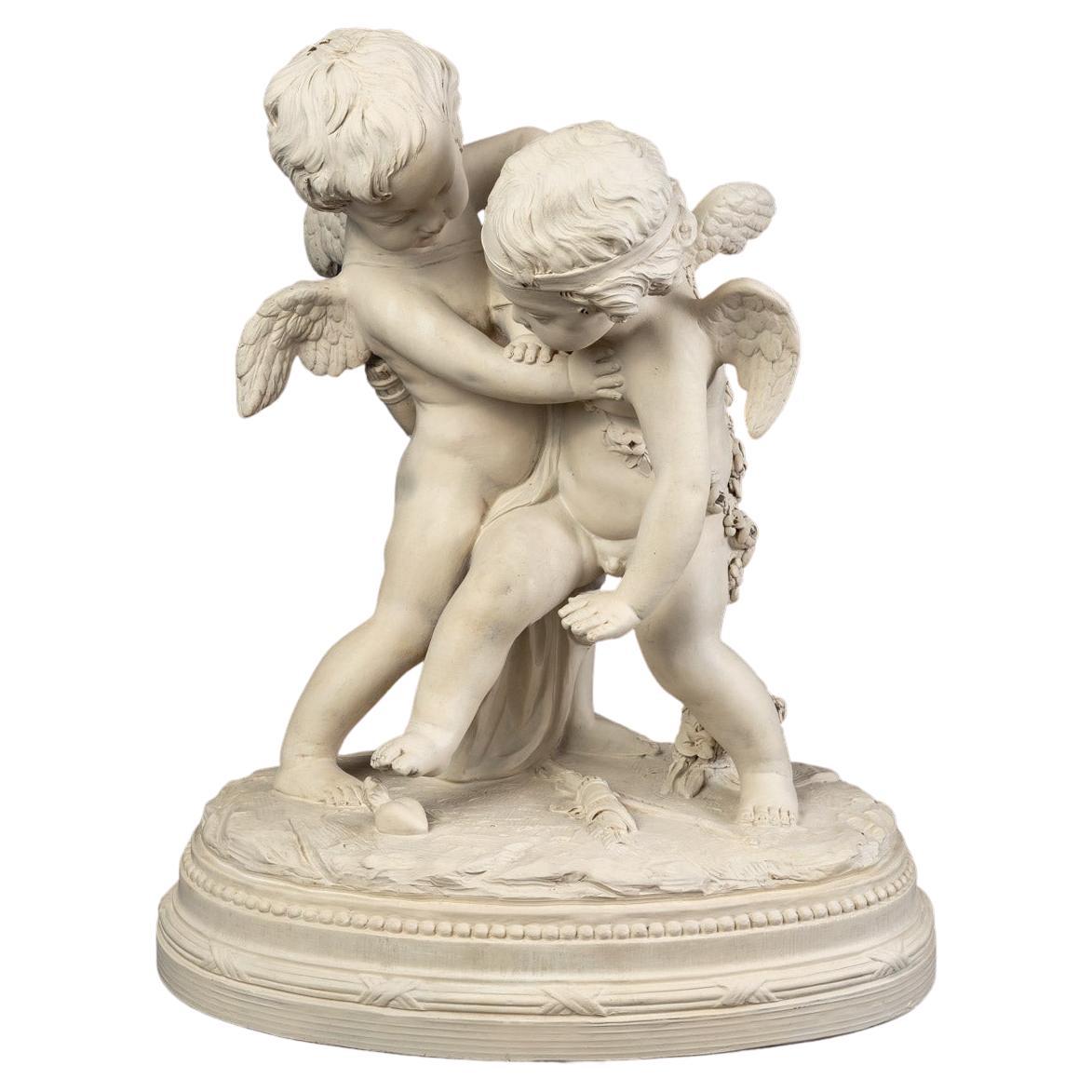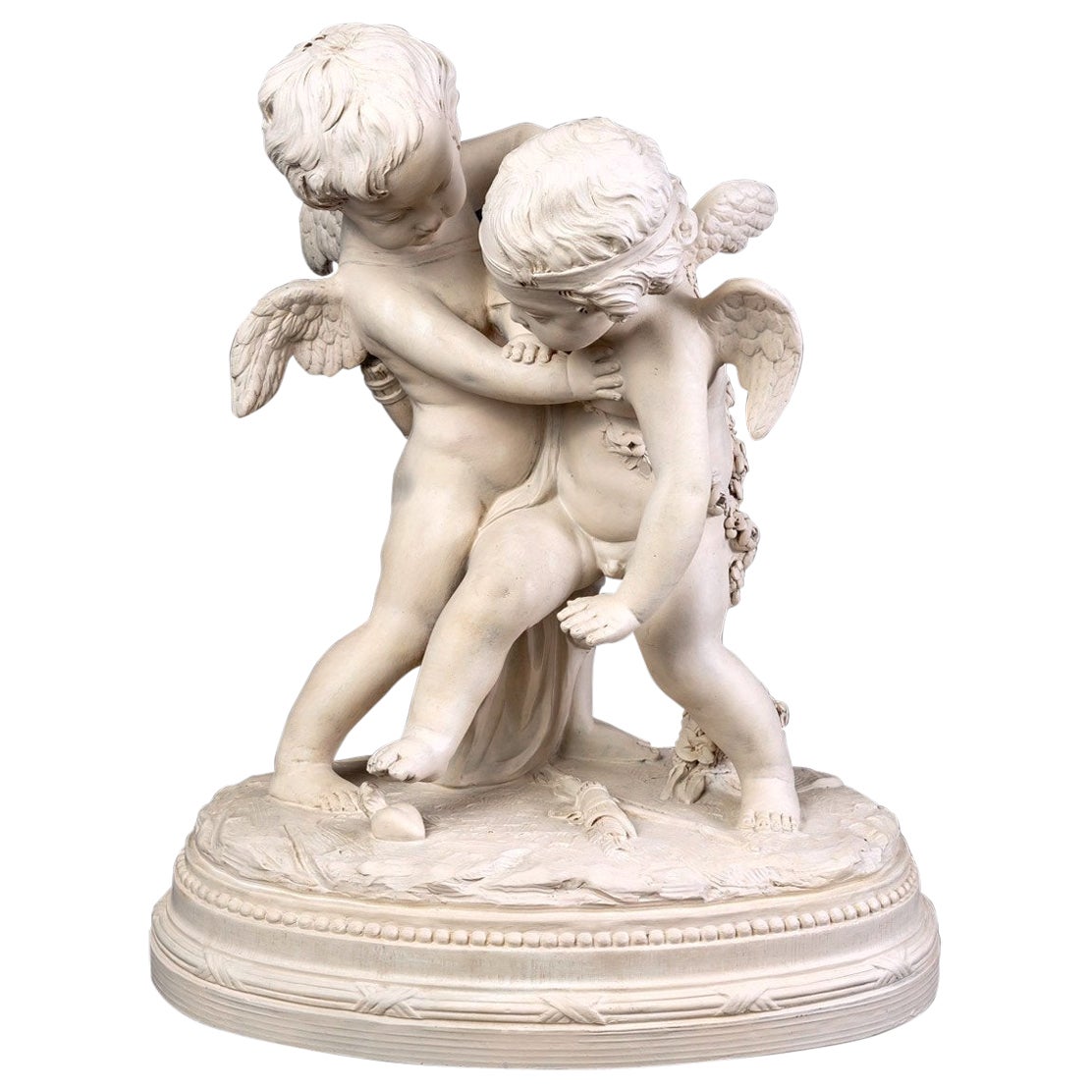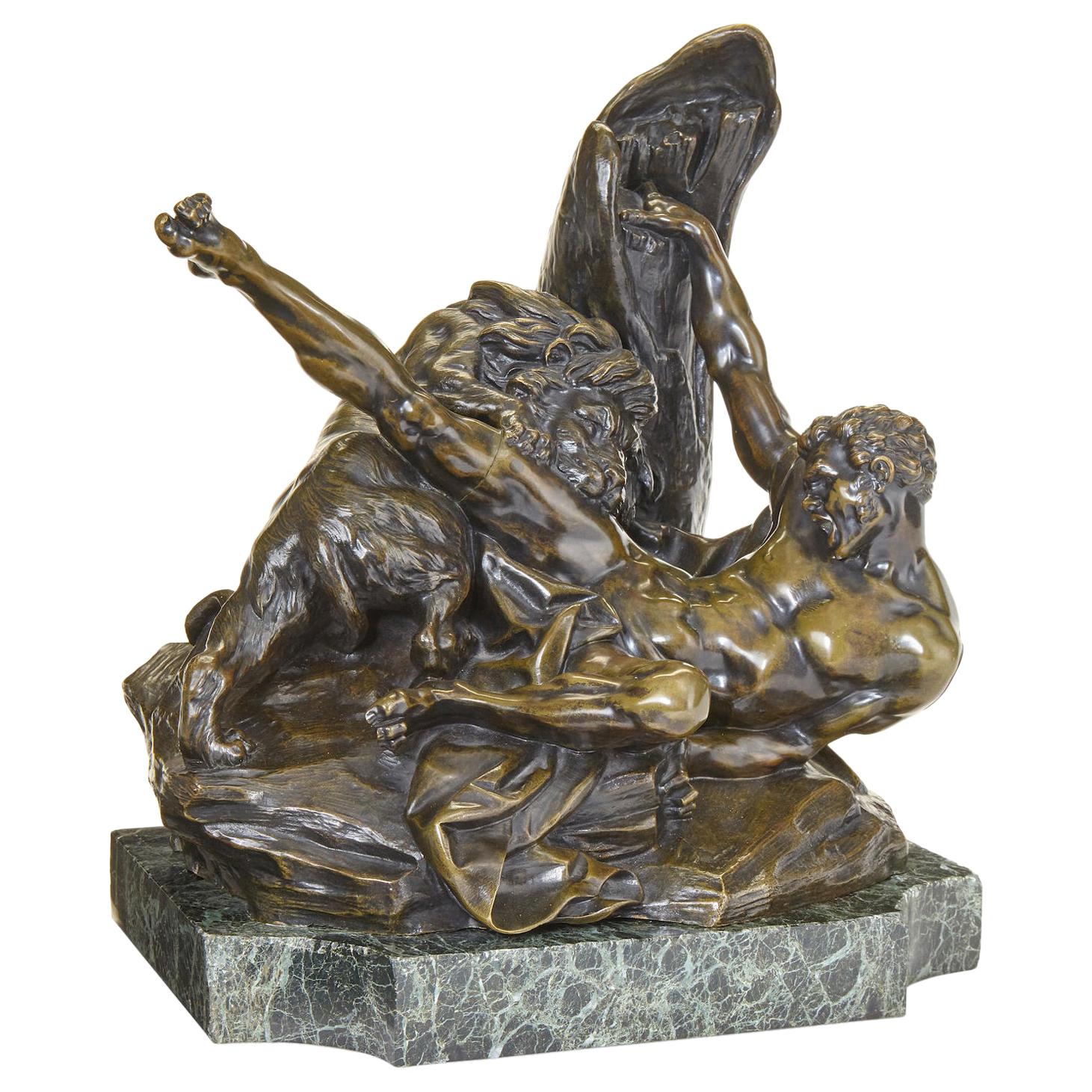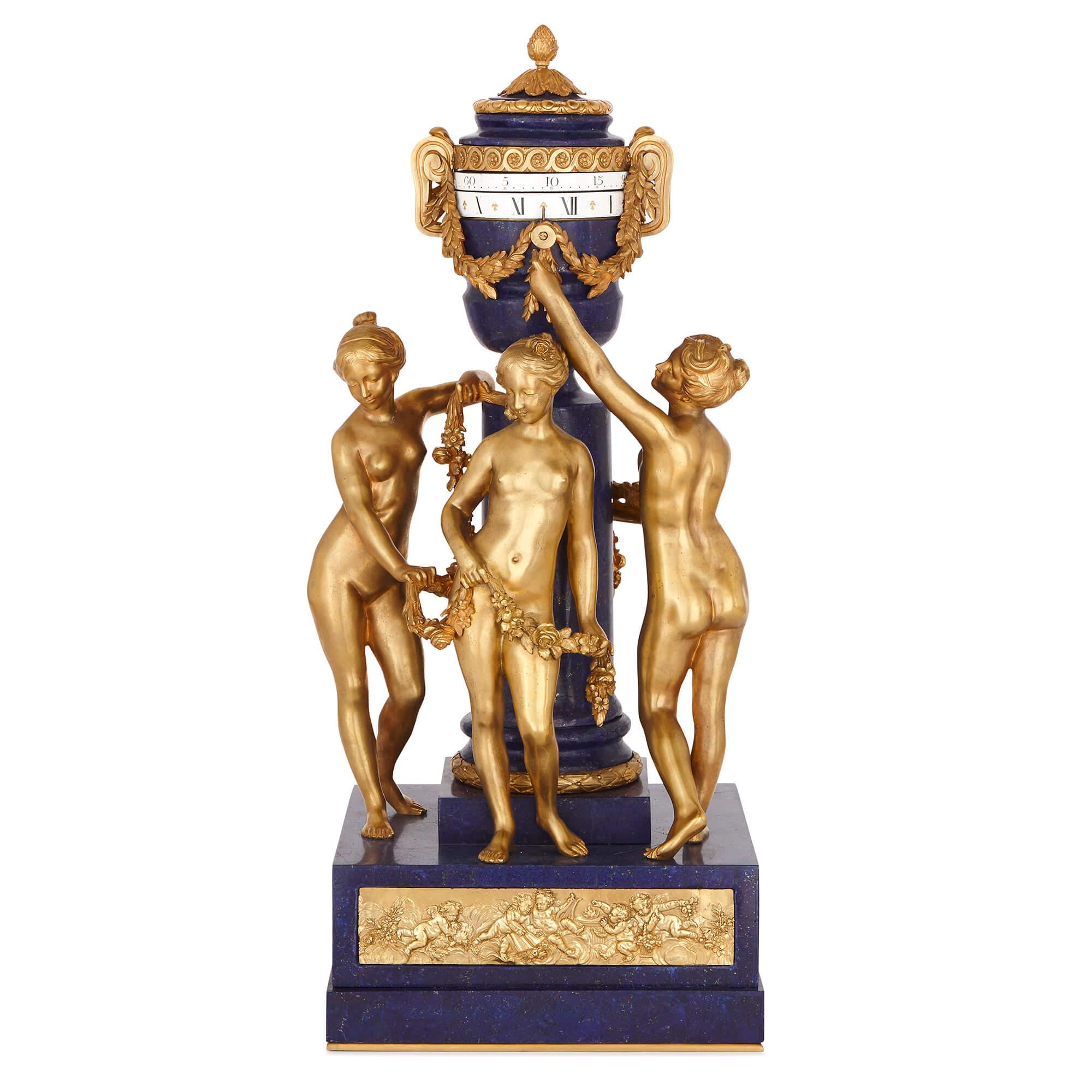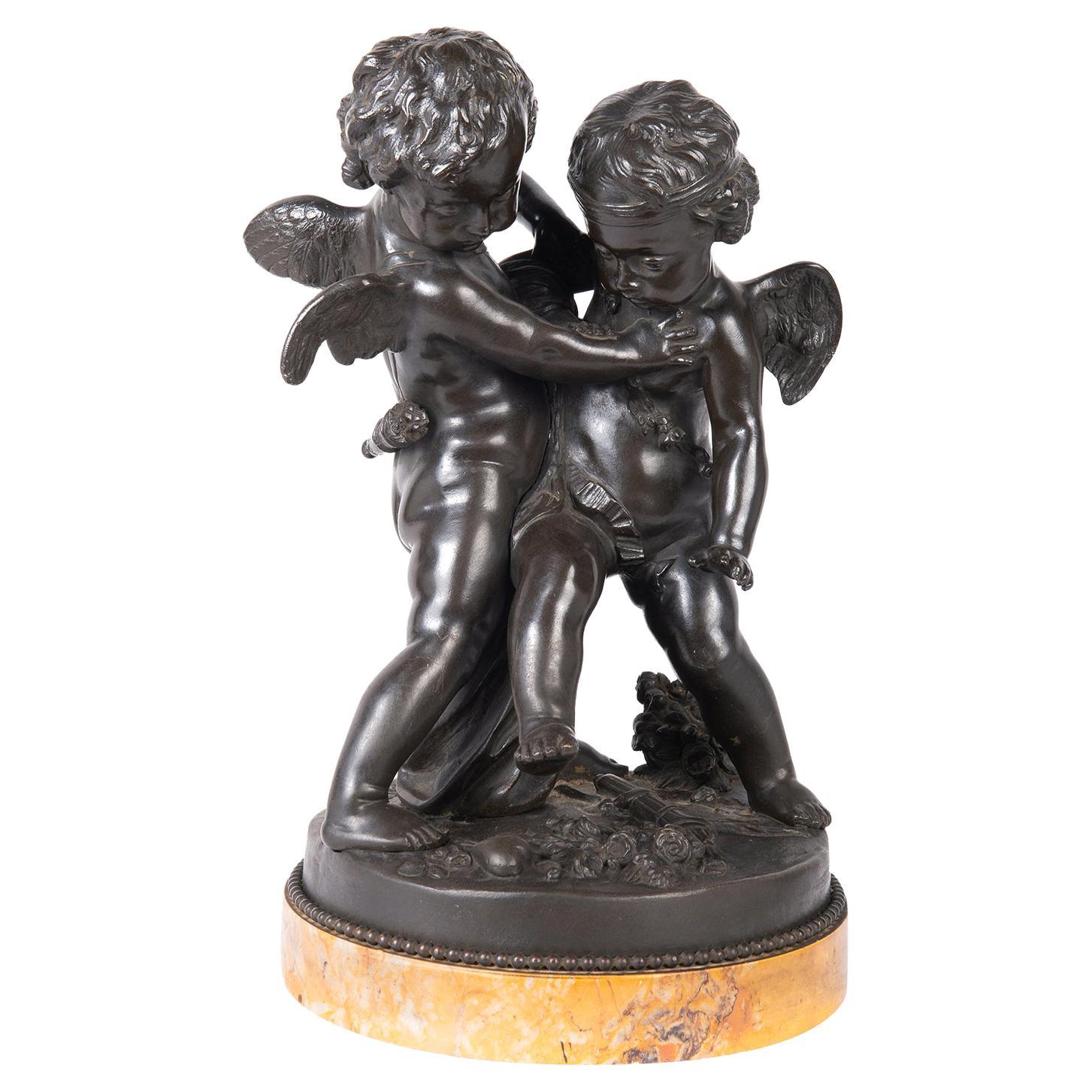Items Similar to French Sculpture of Two Cupids Contesting a Heart, After E. Falconet, circa 1850
Want more images or videos?
Request additional images or videos from the seller
1 of 21
French Sculpture of Two Cupids Contesting a Heart, After E. Falconet, circa 1850
About the Item
After the original 18th century sculpture by Falconet, this circa 1850 hand carved French wooden sculpture depicts the Erotes brothers, Eros and Anteros, contesting a flaming heart (symbolic of passion) on foliate-covered ground. A rose (representing love) lays in between the heart and a quiver of arrows on top of a bow. The cupid on the right has longer hair, kept in place by a headband. He is also wearing a floral sash as he reaches towards the heart with his left hand. The cupid on the left is slightly taller, with larger wings and trying to push his brother back. A long piece of fabric hangs between them, folded over itself on the ground.
The tale of the brothers is quite fascinating: Aphrodite was concerned that Eros would never grow because he was too busy distributing love. Aphrodite later gave birth to another son, Anteros. Whenever Eros was near Arteros, Eros would begin to grow; alternatively, when separated, Eros would revert to his original Size. Because of this relationship, Eros was deemed the god of love, while Anteros is the god of requited love, or love returned. Anteros is generally depicted with longer hair, making him the cupid reaching for the heart, while Eros being larger can be attributed to growth from being in close proximity to his brother.
Etienne Falconet, the sculptor of the original work, also has quite an interesting story. Born into a poverty-stricken family in Paris in 1716, Falconet was initially in training to become a carpenter. In his leisure time, he made clay figures, which led to his discovery by the French sculptor, Lemoyne, who would become Falconet’s teacher. Falconet garnered attention from the public after exhibiting at the Salons in the mid-1750s, and by 1757, he was appointed as director of sculpture at the new Sèvres manufactory. In 1766, Falconet left his post in Sèvres to begin commissioned work for Catherine the Great of Russia, completing his most famous work, The Bronze Horseman, in 1782. During his life, Falconet also studied Greek and Latin and wrote several volumes of literary works. His writings and his sculptures can be seen in museums across the world.
The sculpture seen here measures over 30 inches tall and features a rich, golden brown patina. The quality of the work is instantly confirmed by the proportion, dynamism, and details of the subjects. It will make for a fantastic decorative element in any niche, or on any pedestal or center table.
- Similar to:Étienne Maurice Falconet (Sculptor)
- Dimensions:Height: 30.5 in (77.47 cm)Width: 23.75 in (60.33 cm)Depth: 17.75 in (45.09 cm)
- Materials and Techniques:
- Place of Origin:
- Period:
- Date of Manufacture:circa 1850
- Condition:Repaired: Traces of old repairs to some of the wings and a hand of one of the cupids. Wear consistent with age and use. Minor losses. Very good antique condition with light nicks, and wear. Old repairs visible with some losses (part of wing tip and possibly a missing element from the back of the cupid on the left).
- Seller Location:Dallas, TX
- Reference Number:
About the Seller
5.0
Platinum Seller
These expertly vetted sellers are 1stDibs' most experienced sellers and are rated highest by our customers.
Established in 1983
1stDibs seller since 2011
738 sales on 1stDibs
Typical response time: <1 hour
- ShippingRetrieving quote...Ships From: Dallas, TX
- Return PolicyA return for this item may be initiated within 2 days of delivery.
More From This SellerView All
- circa 1880 French Plaster Sculpture of Francois Rene De ChateaubriandLocated in Dallas, TXMade in plaster, circa 1880, this interesting French sculpture depicts Francois Rene de Chateaubriand sitting with his legs crossed in an armchair. A rolled scroll is in his right hand, which rests on his thigh and books and scrolls are strewn beneath the chair. Chateaubriand’s long overcoat is unbuttoned and gathered, showing an elegant frock and bowtie ensemble beneath. Beneath the chair is a shaped plinth with cavetto molding on all sides and “Chateaubriand” incised along the front. Francois Rene de Chateaubriand was born in Saint-Malo, France in 1768, the youngest of 10 children. A noted politician, historian, and author, Chateaubriand had a profound effect on literature, being the first major figure of Romanticism. Chateaubriand was also the original man of letters, a group of French authors that also had burgeoning political careers. A fellow man of letter, Victor Hugo was so inspired by Chateaubriand that he is known for having said “To be Chateaubriand or nothing”. This French plaster sculpture...Category
Antique 1880s French Figurative Sculptures
MaterialsPlaster
- French Bronze Sculpture of Two Dogs, R Varnier for the Salon des Beaux-Arts 1923By R. VarnierLocated in Dallas, TXThis superb French bronze of two shepherds was done for the Salon des Beaux-Arts in 1923 by R. Varnier. Varnier’s ability to sculpt the proper proportions, musculature, and particularly, their emotion, is phenomenal. The dogs are on a mound, chained to a post with their food at its base. One is lying down with an alert face and ears up and forward, while the other is half lunging over his partner with one leg up, his mouth open and his ears forward. The bronze has been patinated and is in very good condition. Varnier’s signature is inscribed on the back base of the bronze as R Varnier...Category
Vintage 1920s French Animal Sculptures
MaterialsBronze
- 18th Century French Carved Sculpture of a Flying CherubLocated in Dallas, TXLightweight and intricately carved, this sculpture depicts a small, winged cherub flying through wispy clouds. The sculpture was hand-carved in France during the 1700’s. The cherub w...Category
Antique 18th Century French Figurative Sculptures
MaterialsWood
- Pair of 19th C, French, Bronze Soldiers, before and After the Fight, H. DumaigeBy Etienne-Henri DumaigeLocated in Dallas, TXStanding over 2 feet tall, these high quality bronze statues depict soldiers during the French revolutionary wars. They are labeled and signed Dumaige (French sculptor, Etienne-Henry Dumaige 1830-1888). The statues show incredible detail, excellent proportion, and retain their original, rich, brown patina, which is still in remarkable condition. Each solider has a raised brass placard on the front of the 1 ½” thick square bases: one reads Avant le combat volontaire de 1792 par Dumaige, H.C, while the other is titled “Apres le combat grenadier de 1792 par Dumaige, H.C.”. The designation “H.C.” stands for Hors concours (“standout”), which is used for artwork that is excluded from competition because it has already claimed top honors elsewhere. Avant, meaning “before” shows our soldier as a volunteer drummer. Drums were used on the battlefield not only to provide cadence for the soldiers, but also to issue orders based on the percussion pattern. Here, our soldier’s drum is attached to a harness that runs across his right shoulder. Both hands are gripping the frame of the drum, while there is a drumstick in his left hand. There is a satchel on the soldier’s back as he stands on grass with a small wood fence behind him. Our soldier has a mustache with long braided hair in the back. He is wearing a fluted bicorne with a pomme tuft and has earrings in both ears. His jacket is knee-length in the back, with tasseled epaulets on the shoulders. Apres, meaning “after”, depicts the man as a grenadier, enjoying tobacco after a conflict. The grenadier...Category
Antique 19th Century French Napoleon III Figurative Sculptures
MaterialsMetal, Brass, Bronze
- Pair of Silvered Wooden Reliquaries from France, Circa 1750Located in Dallas, TXThis pair of silvered wooden reliquaries are from France, circa 1750. The backs are still preserved by wax seals, indicating that the relics were never removed. Each reliquary has...Category
Antique Mid-18th Century French Religious Items
MaterialsSilver
- Life-Size Painted Terra Cotta Sculpture of a Large Hound, Austria, Circa 1880Located in Dallas, TXOriginally from Austria, circa 1880, this life-sized painted terra cotta sculpture depicts a large and regal pinscher. The seated dog has been hand-painted black, with light traces o...Category
Antique Late 19th Century Austrian Animal Sculptures
MaterialsTerracotta, Paint
You May Also Like
- Large Patinated Terracotta Two Loves Disputing a Heart After Falconet 19th C.By Étienne Maurice FalconetLocated in CRÉTEIL, FRMagnificent and large sculpture in patinated terracotta, entitled “Deux amours disputant un cœur” after Étienne Maurice Falconet (1716-1791), resting on a terrace decorated with a frieze of pearls and wrapped reeds, the second half of the 19th century, and is distributed in bronze, marble, alabaster, terracotta. Two winged loves are depicted in a fight to retrieve a heart figured on the base. Period: End of 19th Century Circa: 1898 - 1900 Dimensions: height: 50cm - width of the base: 28cm Signed: "Falconet" on the terrace. Marked hollow: GC Below Artist, man of letters and esthetician, the career of sculptor Etienne Maurice Falconet (1716 - 1791) is particularly exemplary. Overcoming the handicap of his birth, this brilliant autodidact with an extraordinary personality has rubbed shoulders with the greatest. Protected by Mme de Pompadour, a friend of Diderot and the Encyclopedists, he has established himself by his talent and his culture. The work carried out at Saint Roch church and his position as director of sculpture work at the Manufacture de Sèvres are in a way the prelude to his work in Saint Petersburg. The imposing Bronze Horseman...Category
Antique 19th Century Figurative Sculptures
MaterialsTerracotta
- Large Patinated Terracotta - Two Cupids Disputing A Heart After Emfalconet XIXthBy Étienne Maurice FalconetLocated in CRÉTEIL, FRMagnificent and large sculpture in patinated terra cotta, entitled "Two loves disputing a heart" after Etienne Maurice Falconet (1716-1791), resting on a terrace decorated with a frieze of pearls and reeds wrapped in ribbons This work was very successful in the second half of the 19th century, and was produced in bronze, marble, alabaster and terracotta. Two winged lovers are represented in a fight to recover a heart figured on the base. Period : End of XIXth century Circa : 1898 - 1900 Dimensions : Height : 50cm - Width of the base : 28cm Signature : " Falconet " on the terrace. Marked in hollow : GC below Artist, man of letters and aesthetician, the career of the sculptor Etienne Maurice Falconet (1716 - 1791) is particularly exemplary. Overcoming the handicap of his birth, this brilliant self-taught man with an extraordinary personality rubbed shoulders with the greatest. Protégé of Mme de Pompadour, friend of Diderot and the Encyclopedists, he was able to impose himself by his talent and his culture. The works executed at the church of Saint Roch and his position as director of sculpture at the Manufacture de Sèvres are in a way the prelude to his work in Saint Petersburg. The imposing bronze Cavalier...Category
Antique 19th Century Other Figurative Sculptures
MaterialsTerracotta
- 19th Century Bronze Group After FalconetBy Étienne Maurice FalconetLocated in Paris, FRBronze group with brown patina featuring Cupids fighting over a heart after Etienne-Maurice Falconet (1716-1791). This work had a great success in the second half of the 19th century...Category
Antique 19th Century French Louis XVI Figurative Sculptures
MaterialsMarble, Bronze
- Fine French 19th Century Bronze Figure of "Milo of Croton & Lion" After FalconetBy Étienne Maurice FalconetLocated in Los Angeles, CAA very fine French 19th century Patinated bronze Figure of "Milo of Croton and the Lion" after the marble sculpture of Milon de Crotone by renown French...Category
Antique 19th Century French Baroque Figurative Sculptures
MaterialsMarble, Bronze
- Antique French Gilt Bronze and Lapis Lazuli Mantel Clock after FalconetBy Étienne Maurice FalconetLocated in London, GBFrench sculptor Etienne-Maurice Falconet (1716-1791) is the inspiration for this beautiful, sumptuous mantel clock. His clock, crafted in the late 18th Century and now on display at the Louvre Museum, caused such a stir when it was exhibited over 100 years later, at the Great Exhibition in Paris in 1900 that one reviewer claimed that it "attracted so much admiration from the crowds gathered around that the pressure was sufficient at times to endanger its safety." As well as this famed 'Three Graces...Category
Antique 19th Century French Louis XVI Mantel Clocks
MaterialsLapis Lazuli, Ormolu, Bronze
- 19th Century Bronze Cherubs Wrestling, After FalconetBy Étienne Maurice FalconetLocated in Brighton, SussexAn enchanting and classical late 19th century patinated bronze study of two cherubs wrestling over a heart, after Etienne-Maurice Falconet (1716-1791).Category
Antique Late 19th Century French Figurative Sculptures
MaterialsBronze
